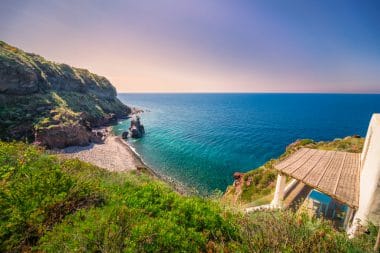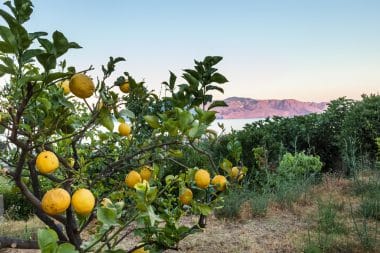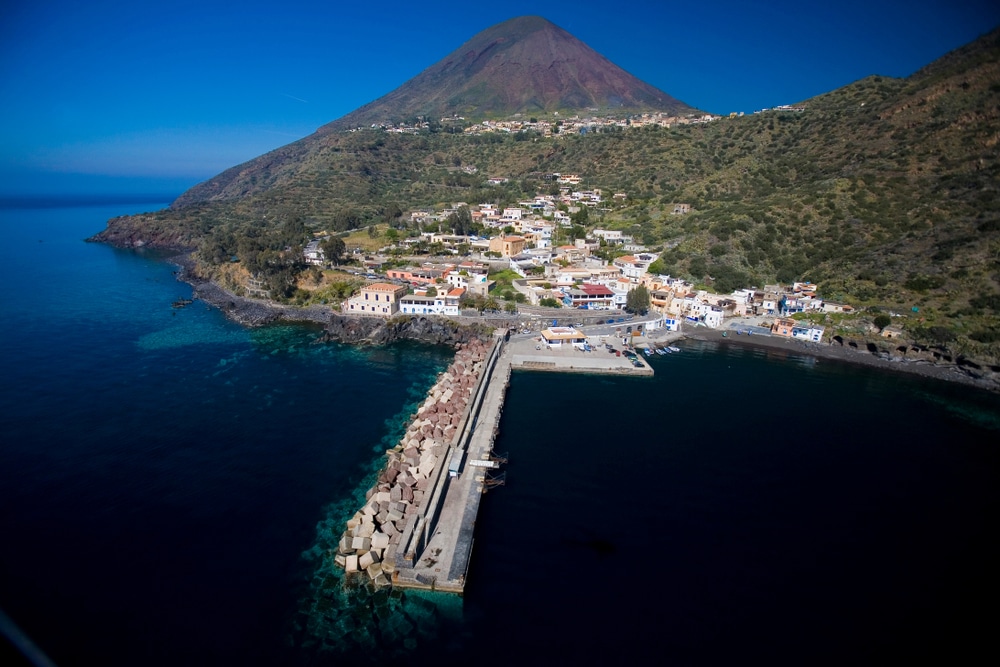Not far from the Sicilian coast lies Salina, the second largest island in the Aeolian archipelago. The small volcanic island in the Tyrrhenian Sea is known for its landscape, beautiful nature and a few tranquil villages. Largely spared from tourism, Salina is considered a special place of peace and bears the beautiful title “Isola Slow”.
Salina – The Green Island

Enjoy with all your senses
Exploring Salina is a special experience, because the green island landscape invites you to long hikes. The landscape is characterized by two volcanoes, whose slopes are now densely overgrown, because the volcanic soil is particularly fertile and ideal for viticulture and agriculture. The lack of beaches makes the island uninteresting for typical beach vacationers, but for nature lovers and those in need of peace and quiet, the island is a paradise. If you still want to enjoy a little cooling in the sea after a hike, you can visit a small swimming strip between Rinella and Lingua. But the charm of the island lies in the fact that you can see, feel and even smell the beautiful nature here. Dreamlike avenues of acacia trees attract visitors to Salina, as do the fishing ports of Santa Marina and Rinella, which are located on the steeply sloping coast and are one of the few villages on the island. If you spend a few days on Salina, you will find that you can also taste nature, because the island’s cuisine relies on the local food, so that the dishes are particularly tasty.
Deceleration – not a conscious decision on Salina

General information
- Layer: Salina is part of the Aeolian (or Lipolian) Islands and is located in the Tyrrhenian Sea, north of Sicily, Italy. It is the second largest of the Aeolian Islands.
- Area: The island has an area of about 27 square kilometers.
- Population: Salina has a population of about 2,500 inhabitants, spread over several villages.
Nature and Environment:
- Volcanic origin: The island is of volcanic origin, like all the Aeolian Islands. It consists of two inactive volcanoes, Monte Fossa delle Felci (962 m) and Monte dei Porri (860 m). Monte Fossa delle Felci is the highest point on the island and the highest volcano in the entire archipelago.
- Emerald Isle: Salina is often referred to as the greenest island of the Aeolian Islands. The fertile volcanic soils favor the cultivation of wine, capers and olives.
- Flora and fauna: The island is rich in vegetation, including dense forests, olive groves, vineyards and fields of caper plants. It is also home to some rare species of birds and endemic plants.
Tourism:
- Beaches: Salina has several beautiful beaches with clear waters, including the popular Pollara beach, which is located in a half-submerged volcanic crater and is known for its picturesque sunsets.
- Wander: There are many hiking trails that lead through the green hills and mountains of the island. One of the most famous routes is the ascent to Monte Fossa delle Felci, from the summit of which you can enjoy a breathtaking view of the Aeolian Islands and the Tyrrhenian Sea.
- Wine and capers: Salina is known for its sweet Malvasia wine and high-quality capers. Many wineries offer tastings, and there are numerous restaurants that offer local specialties.
- Pollara: Pollara is a small village and famous as the filming location of the 1994 film “The Postman” (“Il Postino”). It attracts movie buffs who want to experience the stunning setting.
Reachability:
- Ferries: Salina is easily accessible by ferries and speedboats. There are regular connections to Salina from the neighbouring islands as well as from Sicily, especially from Milazzo and Messina.
- Transportation on the island: The island has a well-developed road infrastructure, and there are bus connections between the villages. Many visitors also explore the island by bike or on foot.
Special features:
- Villages: Salina has several charming villages:
- Santa Marina: The largest village and main port on the island, known for its shops, restaurants and picturesque streets.
- Malfa: Another important village, famous for its wineries and its proximity to the most beautiful beaches.
- Leni: A smaller village near Monte Fossa delle Felci, from which hikes start.
- Nature reserves: A large part of the island is part of the “Riserva Naturale Orientata delle Montagne delle Felci e dei Porri” nature reserve, which protects the volcanic peaks and the surrounding nature.
Economy:
- Agriculture: Salina is famous for the cultivation of capers, which are among the best in the world, as well as for viticulture, especially Malvasia wine. Agriculture is the main source of income on the island, along with tourism.
- Tourism: Tourism plays an increasingly important role in the island’s economy, especially sustainable and ecological tourism that respects Salina’s nature and culture.
Culture:
- Stronghold: Salina has a rich cultural tradition, and there are many religious and cultural festivals throughout the year. One of the most important is the feast of the patron saint of the island, the Madonna del Terzito, which is celebrated in July.
- Culinary tradition: In addition to the famous Malvasia wine and capers, the island is known for its fresh seafood and traditional Sicilian cuisine. Many dishes rely on the local cultivation of ingredients such as tomatoes, olives and eggplants.


